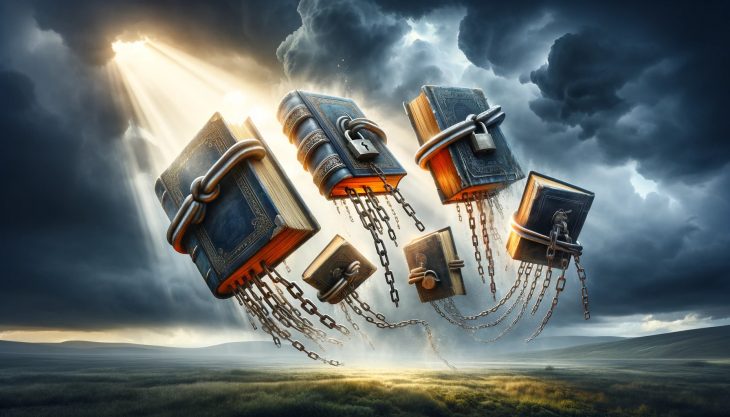
Book-banning culture or imposing censorship on certain literature pieces get opposing views all the time. The opposition thinks that it discourages the freedom of speech and hinders the process of education. It restricts information and suppresses new perspectives that might be beneficial for society.
On the other hand, people who support book banning have the opinion that the content in some books might influence their kids negatively, and they might get swayed on the wrong side.
The reasons for book banning are various. Like,
- Anti-family
- Sexually explicit content
- Drugs
- Offensive language
- Unsuitable for certain age groups
- Racist content
- LGBTQIA+ content
Parents challenge books most of the time. They make writers remove the problematic pieces from them. Historically, many top-rated and best-selling books faced challenges.
Following are some top titles that got banned for different reasons.
1. Harry Potter: Due to the portrayal of witchcraft
Harry Potter series has enjoyed unprecedented success and made its writer, J.K. Rowling, the world’s first writer to reach a net worth of $1 billion. On the same side, it has faced censorship in many countries as well.
Due to its plotline that contains magic, witchcraft, and sorcery, it has been banned in Saudi Arabia, Malaysia, and the Philippines. Moreover, it has been excluded from the school curriculum in the UAE. According to BBC News, the Emirates’ Ministry of Education and Youth believed the content is unIslamic since it revolves around supernatural and magic.
2. The Diary of a Young Girl: Due to sexually explicit content
The Diary of a Young Girl or The Diary of Anne Frank has significant importance in world history. She was a young Jewish girl who lived in Amsterdam and faced the brutality of the Holocaust in the era of Adolf Hitler. She was a diarist and always wrote about her thoughts and war atrocities when she was hiding with her family.
Her private diary became an important war document and was published in 1947 for the public. Since its appearance, the book attracted both praise and censorship. Many critics, school stakeholders, and parents consider some passages of the book pornographic and homosexual. How the writer described her anatomical transformation in her teens unsettled many readers.
Despite treating it as a resource for the section “Education” many parents of school children in Wise County, Virginia, complained about its sexually explicit content. The controversy is revived again in recent years when a Texas teacher was fired for reading the problematic content aloud in the class from the graphic adaptation of the book.
3. Harriet the Spy: Due to the plot that encourages lying and impolite behavior
Written by Louise Fitzhugh, this story is about a little girl from NY. She had a spy notebook in which she used to write her everyday observations. To some extent, their stalking and spying routines becoming creepier.
Critics consider her character as self-centered, selfish, heartless, and mean. The abrasive, liar, and impolite protagonist gets under criticism. She used to fight with her parents and peers when her spy book fell into their hands. There are several studies conducted on her autism spectrum disorder (ASD).
4. Where the Wild Things Aren’t: Due to scary illustrations
There were two important reasons for its banning. One is the scary graphics that were inappropriate for young minds. The plotline and illustrations did not care about the psychological effects the “dark story theme” story could have on the children. Therefore, it was not considered suitable for children to read.
Secondly, Max, the protagonist’s behavior towards his mother was harsh and disrespectful. Her mother, in reaction, did not scold him in one of the scenes.
These reasons made Maurice Sendak one of the most frequently challenged authors of the 21st century.
5. Charlie and the Chocolate Factory: Due to poor life philosophy and offensive language
This book also faced criticism, like the other works of Roald Dahl. He wrote racist remarks and depicted a poor philosophy of life in the story. Moreover, the protagonist did not have any significant good traits.
He made some racist remarks about the height and color of different characters in the story. For example, he called Oompa Loompas small black pygmies and small men. Hence, some groups challenged it.
The later versions were published with the revised content, and specific phrases were removed. However, it did not satisfy all critics.
Conclusion
Books banning has its own pros and cons. While it successfully protects children from getting exposed to adult or violent content, it also restricts them from learning about different perspectives.
Was this page helpful?
Our commitment to delivering trustworthy and engaging content is at the heart of what we do. Each fact on our site is contributed by real users like you, bringing a wealth of diverse insights and information. To ensure the highest standards of accuracy and reliability, our dedicated editors meticulously review each submission. This process guarantees that the facts we share are not only fascinating but also credible. Trust in our commitment to quality and authenticity as you explore and learn with us.
